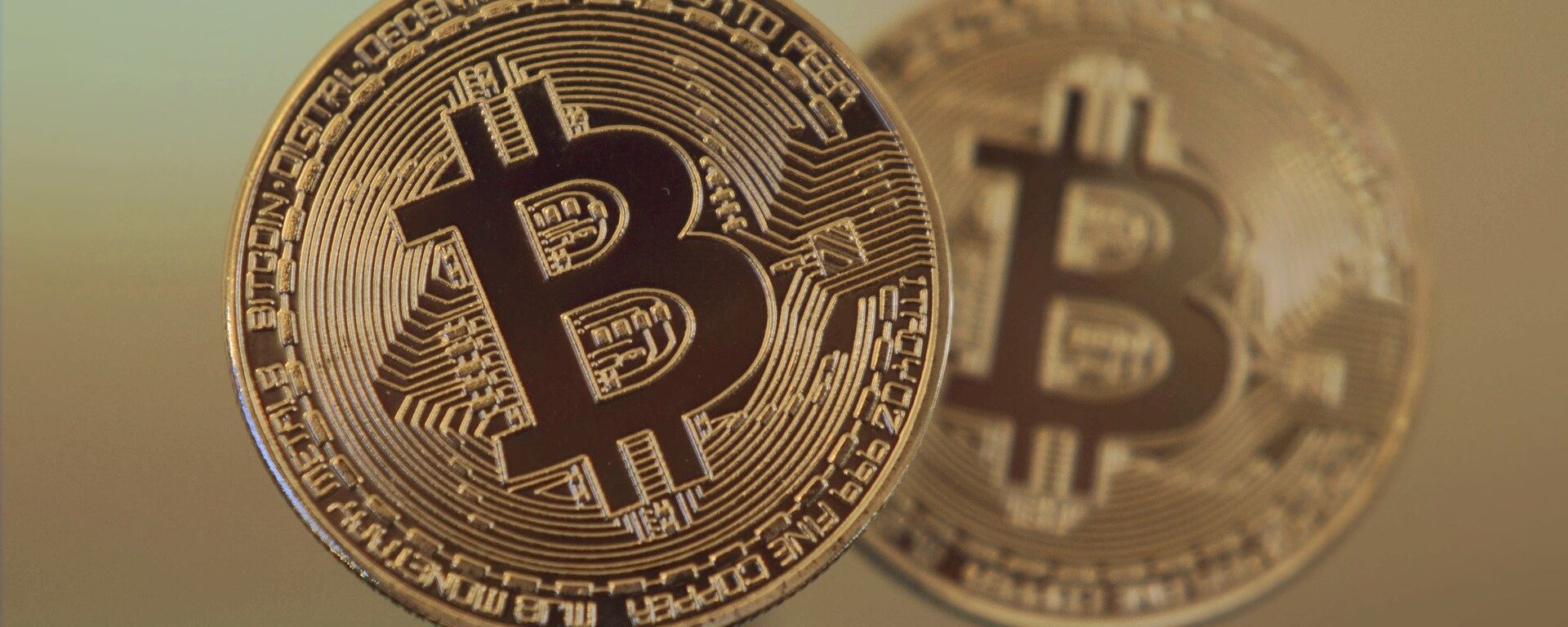https://sputnikglobe.com/20220916/ethereum-completes-the-merge-switching-to-environmentally-friendly-pos-system-1100837279.html
Ethereum Completes ‘The Merge’ Switching to Environmentally Friendly PoS System
Ethereum Completes ‘The Merge’ Switching to Environmentally Friendly PoS System
Sputnik International
Cryptocurrencies are decentralized digital currencies with no central issuer. They are secured by the thousands of computers around the world running the... 16.09.2022, Sputnik International
2022-09-16T03:19+0000
2022-09-16T03:19+0000
2023-07-31T17:13+0000
world
crypto
crypto-trading exchange
ethereum
crypto currency
https://cdn1.img.sputnikglobe.com/img/106406/25/1064062592_0:88:1600:988_1920x0_80_0_0_52371c6ef0bd35efa06516b317cc8e2c.jpg
Ethereum, the world’s second-largest cryptocurrency, has switched to a proof-of-stake validating method, virtually eliminating the cryptocurrency’s environmental impact.The move was in the works for years and completely changed the way Ethereum’s network is secured. Previously, Ethereum used proof-of-work to validate its transactions, not unlike Bitcoin. While there are cryptocurrencies that use proof-of-stake already and have been for years, Ethereum is far larger than any of them with a roughly $200 billion market cap, a huge prize for any hacker that can find a way to beat the system.However, plenty of proof-of-stake cryptocurrencies have had market caps in the several billion dollar range, and have thus far proven capable of securing the system. Cardano, the largest proof-of-stake coin by market cap before Ethereum’s switch, is worth roughly $16 billion.Cryptocurrency transactions are validated on a decentralized network of users that ensure transactions are valid, and the accounts that do that work are rewarded with newly minted coins or through transaction fees. Bitcoin and Ethereum before the merge used a proof-of-work system.In overly simplistic terms, miners were essentially asked to guess a number that would match the hash of the group of transactions being added to the blockchain. The higher percentage of total networking power a user had, the higher the chance that the user’s computers would guess the right number and would be rewarded. The transaction would then be added to the blockchain and propagated across the network.This was trivial during Bitcoin’s early days and could be done on an average laptop. However, to prevent an entity from spamming false transactions, or from taking over the network, the difficulty of guessing the number increases as more computing power (called hash rate) is added to the network. Proof-of-work is essentially a roundabout way to convert electricity into cryptocurrencies. Today, most Bitcoin is mined in giant server farms that expend an incredible amount of energy and are extremely expensive to set up and maintain.Proof-of-stake still uses validators but requires users to lock up their cryptocurrency, preventing it from being bought or sold. Each staked coin (called ETH in the Ethereum network) is essentially a lottery ticket to earn the right to be the first account to validate a transaction and add it to the blockchain and earn the reward. The transaction will then be validated by other computers in the network as it propagates.Along with the move to proof-of-stake, there are other changes to how Ethereum will be created in the future. Ethereum, unlike Bitcoin, did not previously have a set number of coins, making it an inflationary currency, while most cryptocurrencies, Bitcoin included, are deflationary. With the move to proof-of-stake, Ethereum’s creation will be far slower than it was previously and may become deflationary. The miner rewards are gone and only the Consensus layer issuance remains (Ethereum allowed users to stake ETH previously, but most of the reward went to proof-of-work miners). This will result in 89.4% less ETH being created annually and should initially reduce inflation to 0.49%, a number that could go lower in the future if Ethereum ever increases its burn rate.Burning, in cryptocurrency terms, is when coins are sent to an address no one controls, essentially taking the coins out of circulation forever. Since August 2021, Ethereum has been burning transaction fees, which given an average of 13 million ETH being staked, should offset the vast majority of the stake rewards created by staking.While traditional economists will say that inflation is essential to fiat currencies, in the cryptocurrency community it is seen as a huge advantage and helps increase the price of an asset since there is continually less of it being created.However, outside of the aforementioned security concerns, there are other issues with the switch to proof-of-stake.As of Monday, 64% of staked ETH was controlled by five entities. While each account is limited to staking 32 ETH at any one time, Ethereum, like most cryptocurrencies, is pseudonymous (the remaining are fully anonymous), meaning that anyone could create as many Ethereum wallets as they want and stake 32 ETH in all of them.Essentially, with proof-of-stake cryptocurrencies, the rich continually get richer. While it is true that Bitcoin mining requires a significant investment beyond the financial means of most users, any entity with enough financial backing could join at any time and take a significant portion of the total hashing rate. Bitcoin users can also join pools, combining their computing power for a corresponding fraction of the reward. In addition, smaller proof-of-work coins can be mined for relatively cheap.While the environmental impact of Ethereum itself will be much lower, don’t expect global emissions to suddenly drop because of the change. The miners who were securing the Ethereum network did not simply vanish or give up. Instead, they are moving on to other proof-of-work coins that use the same algorithm as Ethereum (Ethash). Ethereum Classic, which continued the old chain after Ethereum forked to roll back a smart contract that went awry and cost investors hundreds of millions of dollars, saw its hash rate increase by more than 296%.Ethereum miners cannot move their equipment to Bitcoin, because it uses a different algorithm for its proof-of-work mining, SHA256.In addition, Chandler Gou, who was a major Ethereum miner and was highly influential in the creation of Ethereum Classic, has led the charge to fork Ethereum again to make ETHPOW (Ethereum proof-of-work), continuing on the pre-merge Ethereum blockchain with a new proof-of-work coin.Still, because Ethereum Classic and other Ethash proof-of-work coins are far less valuable than Ethereum, miners may not be able to recoup electricity expenses in those coins and may eventually shut their equipment down. Thus, the move of the world’s second-largest cryptocurrency to the far more environmentally friendly proof-of-stake can be seen as a major win for those concerned about the environmental impact of cryptocurrencies.Ethereum co-creator and its most visible advocate, Vitalik Buterin, called the switch “The first step in Ethereum’s big journey towards being a very mature system, but there are still steps left to go,” during a Merge viewing party on Thursday.
https://sputnikglobe.com/20220826/taliban-shuts-down-crypto-exchanges-as-central-bank-warns-of-severe-economic-consequences-1100034028.html
https://sputnikglobe.com/20220726/us-treasury-to-fine-crypto-exchange-kraken-for-iran-sanctions-violations---reports-1097830406.html
Sputnik International
feedback@sputniknews.com
+74956456601
MIA „Rossiya Segodnya“
2022
News
en_EN
Sputnik International
feedback@sputniknews.com
+74956456601
MIA „Rossiya Segodnya“
Sputnik International
feedback@sputniknews.com
+74956456601
MIA „Rossiya Segodnya“
crypto, crypto-trading exchange, ethereum, crypto currency
crypto, crypto-trading exchange, ethereum, crypto currency
Ethereum Completes ‘The Merge’ Switching to Environmentally Friendly PoS System
03:19 GMT 16.09.2022 (Updated: 17:13 GMT 31.07.2023) Cryptocurrencies are decentralized digital currencies with no central issuer. They are secured by the thousands of computers around the world running the network by validating transactions for a share of newly minted coins and transaction fees.
Ethereum, the world’s second-largest cryptocurrency,
has switched to a proof-of-stake validating method, virtually eliminating the cryptocurrency’s environmental impact.
The move was in the works for years and completely changed the way Ethereum’s network is secured. Previously, Ethereum used proof-of-work to validate its transactions, not unlike Bitcoin. While there are cryptocurrencies that use proof-of-stake already and have been for years, Ethereum is far larger than any of them with a roughly $200 billion market cap, a huge prize for any hacker that can find a way to beat the system.
However, plenty of proof-of-stake cryptocurrencies have had market caps in the several billion dollar range, and have thus far proven capable of securing the system. Cardano, the largest proof-of-stake coin by market cap before Ethereum’s switch, is worth roughly $16 billion.
Cryptocurrency transactions are validated on a decentralized network of users that ensure transactions are valid, and the accounts that do that work are rewarded with newly minted coins or through transaction fees. Bitcoin and Ethereum before the merge used a proof-of-work system.
In overly simplistic terms, miners were essentially asked to guess a number that would match the hash of the group of transactions being added to the blockchain. The higher percentage of total networking power a user had, the higher the chance that the user’s computers would guess the right number and would be rewarded. The transaction would then be added to the blockchain and propagated across the network.
This was trivial during Bitcoin’s early days and could be done on an average laptop. However, to prevent an entity from spamming false transactions, or from taking over the network, the difficulty of guessing the number increases as more computing power (called hash rate) is added to the network. Proof-of-work is essentially a roundabout way to convert electricity into cryptocurrencies. Today, most Bitcoin is mined in giant server farms that expend an incredible amount of energy and are extremely expensive to set up and maintain.

26 August 2022, 15:34 GMT
Proof-of-stake still uses validators but requires users to lock up their cryptocurrency, preventing it from being bought or sold. Each staked coin (called ETH in the Ethereum network) is essentially a lottery ticket to earn the right to be the first account to validate a transaction and add it to the blockchain and earn the reward. The transaction will then be validated by other computers in the network as it propagates.
Along with the move to proof-of-stake, there are other changes to how Ethereum will be created in the future. Ethereum, unlike Bitcoin, did not previously have a set number of coins, making it an inflationary currency, while most cryptocurrencies, Bitcoin included, are deflationary. With the move to proof-of-stake, Ethereum’s creation will be far slower than it was previously and may become deflationary. The miner rewards are gone and only the Consensus layer issuance remains (Ethereum allowed users to stake ETH previously, but most of the reward went to proof-of-work miners). This will result in 89.4% less ETH being created annually and should initially reduce inflation to 0.49%, a number that could go lower in the future if Ethereum ever increases its burn rate.
Burning, in cryptocurrency terms, is when coins are sent to an address no one controls, essentially taking the coins out of circulation forever. Since August 2021, Ethereum has been burning transaction fees, which given an average of 13 million ETH being staked, should offset the vast majority of the stake rewards created by staking.
While traditional economists will say that inflation is essential to fiat currencies, in the cryptocurrency community it is seen as a huge advantage and helps increase the price of an asset since there is continually less of it being created.
However, outside of the aforementioned security concerns, there are other issues with the switch to proof-of-stake.
As of Monday, 64% of staked ETH was controlled by five entities. While each account is limited to staking 32 ETH at any one time, Ethereum, like most cryptocurrencies, is pseudonymous (the remaining are fully anonymous), meaning that anyone could create as many Ethereum wallets as they want and stake 32 ETH in all of them. Essentially, with proof-of-stake cryptocurrencies, the rich continually get richer. While it is true that Bitcoin mining requires a significant investment beyond the financial means of most users, any entity with enough financial backing could join at any time and take a significant portion of the total hashing rate. Bitcoin users can also join pools, combining their computing power for a corresponding fraction of the reward. In addition, smaller proof-of-work coins can be mined for relatively cheap.
While the environmental impact of Ethereum itself will be much lower, don’t expect global emissions to suddenly drop because of the change. The miners who were securing the Ethereum network did not simply vanish or give up. Instead, they are moving on to other proof-of-work coins that use the same algorithm as Ethereum (Ethash). Ethereum Classic, which continued the old chain after Ethereum forked to roll back a smart contract that went awry and cost investors hundreds of millions of dollars, saw its hash rate increase by more than 296%. Ethereum miners cannot move their equipment to Bitcoin, because it uses a different algorithm for its proof-of-work mining, SHA256.
In addition, Chandler Gou, who was a major Ethereum miner and was highly influential in the creation of Ethereum Classic, has led the charge to fork Ethereum again to make ETHPOW (Ethereum proof-of-work), continuing on the pre-merge Ethereum blockchain with a new proof-of-work coin.
Still, because Ethereum Classic and other Ethash proof-of-work coins are far less valuable than Ethereum, miners may not be able to recoup electricity expenses in those coins and may eventually shut their equipment down. Thus, the move of the world’s second-largest cryptocurrency to the far more environmentally friendly proof-of-stake can be seen as a major win for those concerned about the environmental impact of cryptocurrencies.
Ethereum co-creator and its most visible advocate, Vitalik Buterin,
called the switch “The first step in Ethereum’s big journey towards being a very mature system, but there are still steps left to go,” during a Merge viewing party on Thursday.





